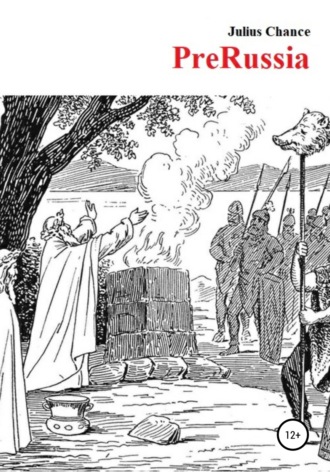
Julius Chance
PreRussia
Historical names associated with Russia
Klassen E.I. writes that there was a river Rsa (also called Rasa) on the land owned by Troy. Wherever the Russ settle we find a river of that name. The present river Arake is an ancient Rsa; the river Araks in the Caucasus was called El-Ras by the Arabs, Orsay and Raskha by the Mongols, Ras and Oros by the Greeks. The Volga was called Rsa when the Russ and the Unna came to it from across the Caspian Sea; one of the rivers is still called Rusa in the Novgorod province where the ancient state of Alaunian Rus used to be; the river Ros flowing into the Dnieper where the Dnieper Rus state used to be; the Russian Sea (the Black Sea) where the Black Rus state used to be; the river Rusa in Moravia where the Rusniaks are still living; the river Rusa being a right tributary of the Memel (the Neman) along which the Pomorian Rus state used to be (the successor of Alaunian Rus).
Perhaps, the list of Russian and semi Russian territories is even more extensive. The well-known linguist V.D. Osipov in his article "The Karian trace" says that in Karia (Asia Minor, the southwest of Turkey) a stone was found with an inscription dating back to the 16th century BC. It is read in Slavic. What do we know about the Carians? Almost nothing apart from the fact that the "father of history" Herodotus was half a Carian… He was born and raised in Halikarkas, his father's name was Luka. It was in the middle of the VI century BC.
From Herodotus we learn that in those distant times the Carians were called "Lelegs". The Pelasgians, the ancestors of the Slavs, were also called Lelegs. And in the great city of Serbin (later renamed to Xanthos by the Greeks) founded in the VIII century BC or earlier (near the city of Lika the former capital of the Lycian Federation on the territory of modern Turkey).
Archeologists and pad a special attention to the "Obelisk of Xanthos" there. It is a high tomb with a large column decorated with an inscription in the Lycian language. All attempts to translate the texts based on ancient Greek and other languages failed. Finally the text was fully deciphered by the priest Svetislav Bilbia (born in 1907 in Bosansko-Grahovo in Bosnia-Herzegovina) using the ancient Serbian language and the alphabet from Lydia and Lycia. So, the territory of original Turkey also has some previous Slavic strata.
The Russian academician Chudinov V.A. easily deciphered many Etruscan inscriptions about an era that until recently was shrouded in mystery. 46 He proceeded from Russian. The Serbian code of laws of the 8th century BC was found carved on a large stone in the alphabet "Serbica". It is read in Serbian with no much difficulty."
We know from the Vatican archives that after the fall of Etruria (Rasseni, Etruscan Twelve-Grad) and the assimilation of the Etruscans by the Romans, some of the Etruscans left the Apennines to the Russian Plain on the east (according to the instructions on the map) and founded a "second Etruria" there. The Vatican itself is built on the ruins of the City of the Dead named after the pagan goddess Vatica. The city was built by the Etruscans (which are the Slavs).
Among the indigenous Italian names purely Etruscan-Russian names are frequently encountered – Danilo, Ivan, Katia, Nadia, Nastia, Natascia, Vladmir, Tania. The Italians apparently do not realize that they have so many namesakes in Russia. All the inscriptions of the Venedi-Etruscans of Italy are read only in Slavic. Here is an example of a short tombstone inscription: "Lar oe celua". Translation is not required even into modern Russian. It means "I kiss your coffin" – a sorrow for the deceased woman.
Calendar since the Peace Making
Other historians deduce the date of the birth of Russia from the fact that before Peter the Great (Peter-I) the so-called "Calendar since the Peace Making" was widely used in Russia. To calculate the year in that old calendar we need to add 5508 to the year of the modern calendar. For instance, the 2020 year corresponds to 7528 in it. It was still in use during the reign of Peter the Great as a number of documents are dated according to it.

The cover of the "Ulojeniya…" (Set of Rules for Courts) from the free repository https://commons.wikimedia.org under the CC license.
Where did this calendar come from? And what does the date of "making peace in the star temple" mean in it? Here the opinions of historians differ again. Many believe that at that time the Slavs in alliance with the Turkic tribes formed the state of Great Tartary. The historians consider that the calendar’s zero-date is the moment of signing the peace treaty between China and Tartary.
If this is so, then it means that the chronology was conducted even before that. These historians believe that both the Chinese and the Slavs had calendars going back to such a fabulously distant past that not even all the priests had complete knowledge about the events mentioned in the previous calendar. That previous super-ancient calendar is called «Круго Лѣть Числобога» (или «Сороковник») in Slavic, which literary means “Circles of years of Figuregod” (sometimes referred to as "Sorokovnik"). I can easily be found on the Internet as well as in the libraries of some universities and other educational institutions.
It was necessary to cut off some too distant past from that “previous super-ancient” calendar for daily practical use by the ordinary population, leaving the original calendar only for educated priests. Such a "cut-off date" or a new starting point was the date of the signing of the peace treaty after the grandiose war between Tartaria and China. The peace deal was signed in the city of the Star Temple in Northern China just 5508 years BC.47 Thus, the Slavic state and China had existed long the erection of the Egyptian pyramids (if we accept this standpoint).
New DNA evidences
Most of the above information has been known for a long time, but previously it was published only in the so-called "yellow" media. The "official" historians (supporters of the Norman theory) long ignored it all as "fairy tales", "myths" and "fantasies" under the pretext of the alleged absence of firm evidences. However, due to the rapid growth of the amount of "compromising material" against the Norman theory, a few years ago this information began to be published officially and scientists began to receive PhD decrees for their dissertations on this topic.
The firm evidences came in connection with the development of DNA analysis. At first it was believed that if human bones had lain for several millennia then the DNA chain in them disintegrated beyond recognition. However, later it turned out that DNA molecules decay very slowly in some conditions. Moreover first they break up into fragments, then into smaller fragments and only then into primitive molecules of several atoms. Sufficiently long fragments can be extracted from bones several tens of thousands of years old and even from the bones of some Neanderthals. That is, in one place bones may have some parts of DNA preserved, in another – others. By collecting many different pieces from different parts of the bone you can make up the entire complete DNA chain (mathematically). In practice, the situation is much simplified by the fact that scientists do not need a complete DNA chain to establish a race or ethnicity – only those parts of it that contain specific "markers" of one or another people.
In recent years the results of several authoritative DNA studies of fossil remnants have been published. They do confirm all of the above facts about the antiquity of the Slavs and even more. DNA analysis shows that Europe was first populated by the Slavs and only four thousand years later did the Western Europeans come there. Both events occurred thousands of years BC!
One of such publications is a series of books by Anatoly Klesov, the President of the Academy of DNA Genealogy of Russia, professor at the Moscow State and Harvard (USA) Universities: "The origin of the Slavs. DNA genealogy against the ‘Norman theory’" 48, "DNA genealogy of the Slavs. Origin and history" 49, "DNA genealogy of the Slavs. New discoveries." 50
It turned out that both Slavs and Western Europeans came from Southern Siberia. The mutation mark that sits in half of ethnic Russians – DNA label R1A – originated in Southern Siberia about 24 thousand years ago. Our ancestors lived around the Lake of Baikal, in Altai and in the whole of Southern Siberia. They came there from somewhere else as then all the peoples on earth were constantly moving because of climate change, game shortages, etc. The ancestors of the Slavs (Proto-Slavs) came out of Southern Siberia about 20 thousand years ago. They moved along the "southern arc" – through Tibet, India, the Iranian plateau, Turkey and about 9 thousand years ago they reached the Balkans and then settled in Europe. This people became the ancestors of ethnic Russians.
Another mutation, the DNA label R1B, also originated in Southern Siberia (later) and its carriers became the ancestors of Western Europeans. They moved from Southern Siberia to Europe along a longer "northern arc" – through Northern Kazakhstan, the Samara region, the Middle Volga, turned through the Caucasus, the Middle East, North Africa, the Iberian Peninsula, crossed Gibraltar and reached Europe about 5 thousand years ago too. By that time the Proto-Slavs had been living in Europe for 4 thousand years.
The First World War of the Slavs with Western Europeans
The ancestors of the Western Europeans went to war against the Slavs and managed to dislodge them from the territory of Western Europe about 4 and a half thousand years ago. The Slavs retreated to the Russian Plain and lived there for about two thousand years. Then the Western Europeans again moved on the Slavs. Near the Talenzi River (halfway between Berlin and the Baltic Sea) a gigantic battle that took place three thousand two hundred years ago at the end of the second millennium BC. Many bones and weapons were found there, including Slavic clubs and wooden hammers. Both infantry and cavalry participated on both sides. The bone remnants of at least several thousand dead bodies are there. The total number of combatants was obviously much higher, perhaps tens of thousands.
For that time such a number of troops was incredible. Some historians dubbed this battle "the first world war in history." Pulling up such armies, ammunition and food by the roads required transport, logistic chains, hierarchical management and command system. That implies that the statehoods had already been sufficiently formed on both sides.
Since all the towns that appeared later around the battle site got Slavic names, we may assume that this time the Proto-Slavs defeated the ancestors of the Western Europeans and stopped their further advance to the Russian plain. Subsequently many more attempts were made by the Western Europe to break through this border line formed six and a half thousand years ago, but to no avail. Of the latter are the wars of Charles XII, Napoleon and Hitler against Russia.
DNA is against that humanity originated in Africa
Apart from the above Klesov publicized some other surprising facts. One of them is that the Slavs are also descendants of the Aryans (Hitler would be shocked by that). Another one is that neither the Slavs nor the Western Europeans bear the markers of the Africans, which casts serious doubt on the theory that Africa was the cradle of humanity and that homo-sapiens people came from there. Both points are based on DNA analysis and therefore cannot be ignored. However, here we deviated a bit from the initial topic. Thus, the ancient Slavs and their states existed tens of thousands of years before our era and were the contemporaries of Ancient Greece, Egypt and Rome if not older.






